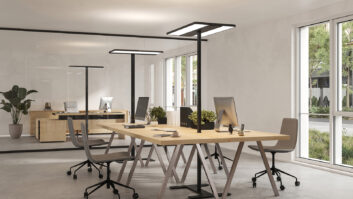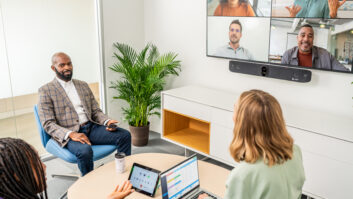Poly has released a new report examining how organisations are preparing for the future of hybrid work, and its impact on the relationship between employers and employees. Almost a fifth (19%) of organisations are expecting staff to come back to the office full time, while more than three-quarters (77%) are planning to redesign the office experience.
Poly’s Recruit, Retain and Grow report provides analysis on findings from a study of over 2,500 business decision makers across the globe. It details how a lack of hybrid work strategies put businesses at risk, the current state of hybrid work policies, culture and wellness in an ever-increasing virtual world, and the future of the office – which is vital to improving employee experience.

Key findings from the report include:
- 58% of organisations have seen a higher turnover in staff over the course of the pandemic
- Less than half of organisations (48%) are fully prepared for the future of hybrid work, whilst 37% are only prepared in the short-term
- Nearly 1-in-5 (19%) employers are asking staff to return to the office full-time
- 81% of organisations are enabling some degree of flexibility – on average employees are being asked to come in 3 days per week, with Wednesday the most popular day to visit the office
- Nearly three-quarters (72%) of organisations saw an increase in productivity since initiating hybrid work, with an average increase in productivity of 27%
- However, almost half of organisations (49%) believe there is an unhealthy culture of overworking within their organisation
- 77% of organisations plan to redesign the office to include more open-plan areas, collaboration spaces, areas to socialise and quiet zones
“Companies are aware that their hybrid work strategy is key to retaining and attracting talent,” explained Paul Clark, EMEA managing director at Poly. “Whilst business continuity was the focus for many companies when the pandemic first hit, they must now focus on creating a hybrid work environment that puts employees first, or risk losing them to competitors.”
The research found that recruiting and retaining staff has become a key challenge for organisations. Over half of organisations (56%) believe that if they don’t address their hybrid work plans, they’ll start to lose staff and will be unable to attract new talent. Indeed, 58% of organisations have seen a higher turnover in staff over the course of the pandemic, while 55% worry that the effects of the Great Resignation combined with skills shortages could put them out of business. Exiting employees disclosed that the top reasons for leaving are tied to their employer’s approach to hybrid work:
- They found something better suited (19%)
- They wanted more flexibility around anytime / hybrid / remote working (16%)
- They didn’t like the shift to hybrid work (14%)
- Under too much pressure to work long hours (12%)
- Unhappiness over handling of COVID (9%)
With organisations struggling to attract and retain talent, the report makes clear that developing an effective, employee-centered hybrid work strategy is critical. However, not everybody is prepared for this next step, with less than half of organisations (48%) saying they are fully prepared for the future of hybrid work, while 37% are only prepared in the short-term. Meanwhile, over half of organisations (52%) believe hybrid work to be a blip and are looking forward to having everyone back in the office. The report also found that:
- Employers are asking staff to come into the office an average of three days a week
- Wednesday is the most popular day to come into the office
- Almost 1-in-5 (19%) organisations are asking employees to come back to the office full-time
Overall, it seems like the shift to hybrid and remote work has seen improvements in productivity. More than seven-in-ten (72%) saw an increase in productivity, with a global average increase of 27%. However, organisations need to be on their guard, as the risk of burnout increases:
- Half (49%) believe there is an unhealthy culture of overworking which they must put a stop to
- 67% say they have a ‘moral duty’ to protect employees from working too much
- Only 51% of organisations have taken steps to prevent people feeling like they need to be always-on, with 38% encouraging employees not to look at work emails outside of working hours and to take regular breaks, while 13% have processes in place to make sure employees aren’t working long hours (e.g., time tracking, set hours)
Poly’s report concludes by calling upon business leaders to consider how they use people, technology, and spaces to create engaging working environments, and encourages leadership teams to take a step further and adopt a people-first approach. This entails considering who uses what space, at what time, or with what frequency and for what purpose, to ensure the right technology is adopted.
While the pandemic has forced organisations to rethink or redesign workspaces, the research has found that 64% of organisations no longer view the office as the face of the company – technology and experience is. In addition, 77% of companies are planning to redesign their office, with more open plan areas, collaboration spaces, quiet zones, and areas to socialise. Organisations are also investing, or planning on investing, in technologies to improve employee experience, including:
Collaboration software (such as Teams or Zoom) (92%)
- Cloud applications (92%)
- Headsets (89%)
- Cameras (86%)
“The fact that so many companies are redesigning their offices suggests we are about to witness a seismic shift in the role of the office,” conludes Clark. “Organisations have to offer employees an incentive for going into the office, and we’re seeing that creating more open-plan areas, collaboration spaces, quiet zones and areas to unwind are high on the list of priorities for many companies. This will give workers an entirely new experience of what office life is like and shift the role of the office for years to come.
“But to ensure an equal experience, organisations must consider how hardware intersects with people’s work habits and preferences, their office space, and other technologies like Zoom or Teams. If they don’t, employees won’t have access to the right tools for them, creating an unequal experience that negatively impacts recruitment, retention, business growth and productivity.”
The full Recruit, Retain and Grow report can be viewed here.







